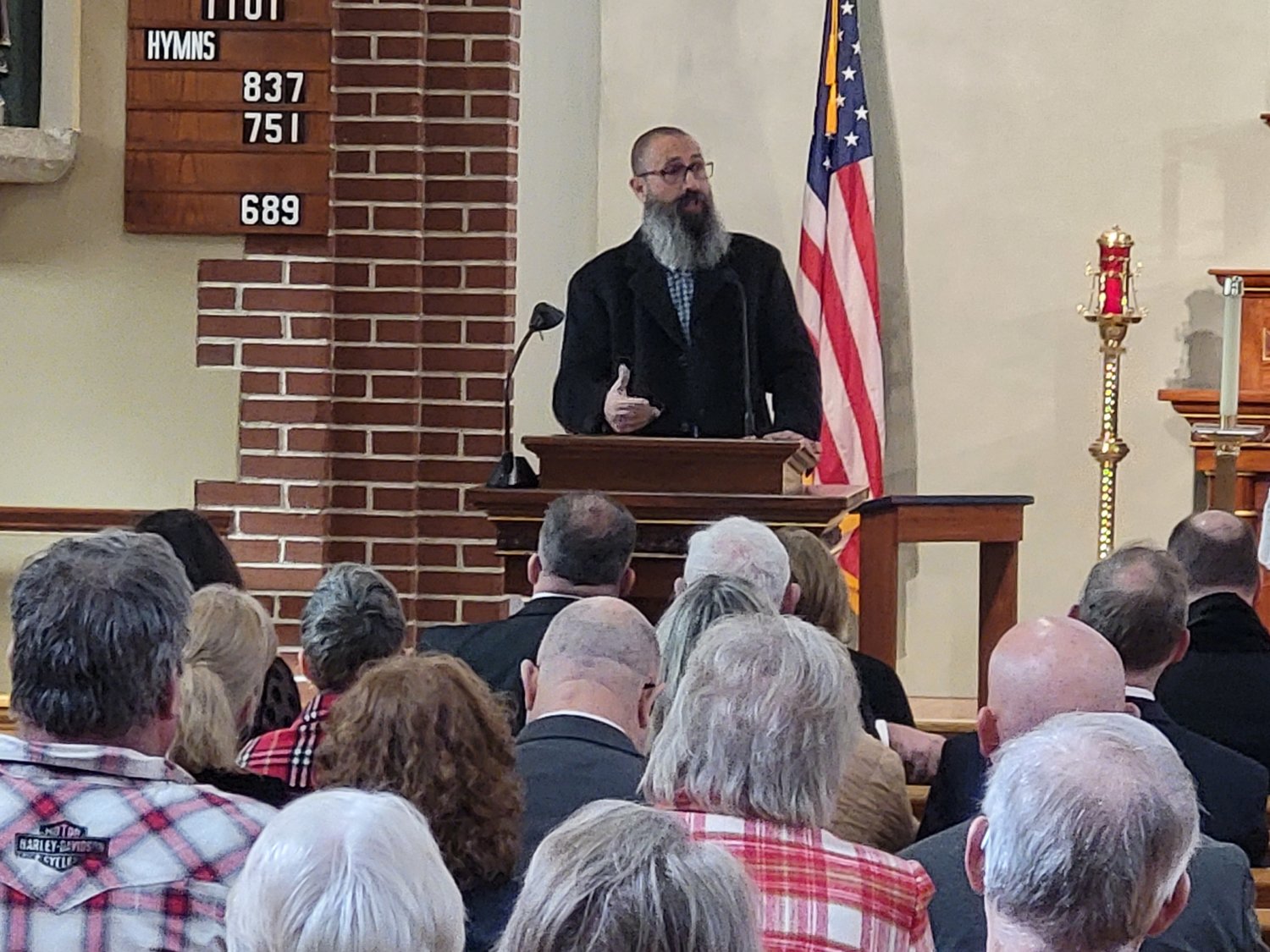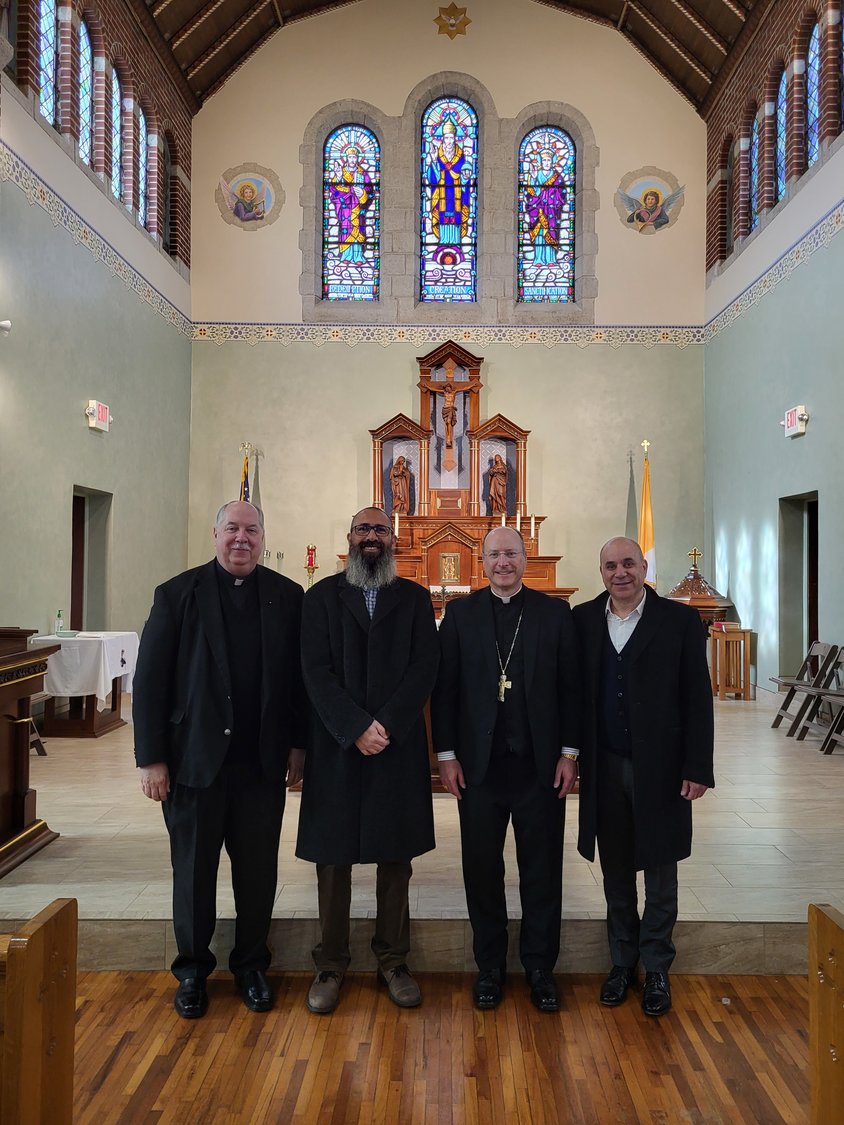Lifelong Old City Jerusalem parishioner visits diocese
Speaks of difficulties for Christians living in the Holy Land

Rami Salfiti is afraid that there will be no more Christians living in the Holy Land by the end of this century.
A lifelong resident of the Old City of Jerusalem and a member of that city’s Church of the Holy Sepulchre Parish, he has watched the Christian population fall to less than 2 percent in Israel and the territories governed by the Palestinian Authority (P.A.).
“Most of the Christians are leaving,” he said, “and within the timeframe of 50 years, there won’t be any Christian parishioners living in Jerusalem.”
When that happens, most of the churches there will only be used and maintained by pilgrims and members of religious orders, he said.
Mr. Salfiti spoke to the public and to members of the Equestrian Order of the Holy Sepulchre of Jerusalem after a Saturday morning Mass in St. Stanislaus Church in Wardsville Feb. 4.
He also gave a presentation the previous afternoon to priests and deacons of the diocese.
Joining him at both were lifetime Old Town Jerusalem native Moses Jarjoui, CEO of his own travel bureau; and George Hudson, CEO of Travel Time in St. Louis.
“I just ask that you go there and see,” he said of the Holy Land. “Because when you go there, you will interact with what we call ‘the living stones.’” (1 Peter 2:5)
Among those who attended his talk were Bishop W. Shawn McKnight; Monsignor Robert A. Kurwicki, diocesan vicar general and pastor of St. Michael Parish in Russellville; and Monsignor David D. Cox, pastor of St. Stanislaus Parish.
All three have attended pilgrimages to the Holy Land led by Mr. Salfiti.
“Most people, especially in the United States, believe that Palestinians are only Muslims,” Mr. Salfiti stated. “But no, in Jerusalem, there are Christians.”
He pointed out that when Jesus’s first followers were following in his footsteps throughout the Holy Land, they were a small minority.
Echoing a 2008 message from Latin Patriarch Emeritus Michel Sabbah of Jerusalem, Mr. Salfiti continued: “This reality is linked directly to the mystery of Jesus in this land. Two thousand years ago, Jesus came here and with his apostles, his disciples and the small number of faithful who believed in him, and they also remained few in number. Today ... the Christians are (still) a small number of witnesses to Jesus in his land.”
“Your guide is the Bible”
Mr. Salfiti noted that about 70 percent of the Holy Land’s Christians make their living on tourism.
“One of the most important things you can do to help the Christians in the Holy Land is to go to the Holy Land,” he said.
He emphasized that people don’t visit the Holy Land as tourists but rather as pilgrims.
“Because this land is the only land in the whole world that when you go there, your guide is the Bible,” he stated.
He said Catholics who visit the Holy Land arrive with knowledge of the four Gospels.
“But when you leave, you leave with a fifth Gospel — namely, everything you saw and encountered and experienced there,” he said.
“Then, any time you read or hear something out of the Bible, you can visualize where it took place, because you were there,” he said.
Shrinking minority
Convinced of the importance of having a community of Christians living in the place where Jesus founded the Church, Mr. Salfiti talked about some of the reasons it’s hard for them to stay.
The cost of living is a major factor.
The Franciscans of the Holy Land and the Catholic Church’s Latin Patriarchate try to help by building lower-cost housing, but they can’t build enough of it, because the land is very expensive.
Most Christians living in Jerusalem are classified as legal residents but not citizens of Israel. Their resident status can be revoked if they don’t follow the law.
Citizens and residents alike are required to pay property taxes.
The average monthly rent in Jerusalem is $1,000. The average income for a Christian in Jerusalem is between $1,200 and $1,500 a month.
“So they would pay at least 75 percent of their income as rent to live there,” said Mr. Salfiti. “That’s why they move to Bethlehem, where the average rent is $400 a month, which they can afford.”
But Bethlehem and the West Bank are under the Palestinian Authority, rather than Israel. People living there don’t pay the Israeli property tax.
“That gives the Israelis the right to withdraw their residency, meaning they won’t ever be living in Jerusalem anymore,” he said.
“It’s a very crucial thing that is facing the younger generations,” he stated. “They can’t afford to get married and stay there.”
Mr. Salfiti pointed out that prior to 1948, when the nation of Israel was created, the total combined population of what is now Israel and the P.A. was 500,000, of whom about 10 percent were Christian.
Three-quarters of a century later, there are about 9 million people living in Israel, of whom 1.33 percent Christian; and about 5 million living under the Palestinian Authority, of whom about 1.6 million are Christian.
The majority among the 14 Christian denominations there are Melkite Catholics, who celebrate their Liturgies according to the Eastern Rite, said Mr. Salfiti.
Jerusalem, the second-largest city in Israel, has about 900,000 inhabitants. Among them are about 6,000 Christians, most living in what is known as the Old City, within the ancient city walls.
The Old City portion of Jerusalem, comprising about 2 square miles, has about 35,000 inhabitants, among whom about 28,000 are Muslims, 4,000 Christians and 3,000 Jews.
There are other difficulties, ranging from scattered instances of vandalism of Christian properties; government-sanctioned expropriation of Church-owned property at the end of multigenerational leases; and the prospect of taxing Church property, Mr. Salfiti stated.
“Come and see”
Mr. Salfiti noted that outside tourism, most of the other 30 percent of Christians in the Holy Land work in Christian institutions, such as churches, monasteries, schools and hospitals, with a tiny minority working in manufacturing.
He pointed out that because there aren’t enough Christians to support such large institutions on their own, most of the students in Catholic schools in the Holy Land, including Bethlehem University, are Muslim.
This helps to build up a spirit of mutual trust and understanding among Christians and Muslims, he stated.
“These schools are doing very good work,” he said.
He suggested that people who want to help keep Christians in the Holy Land in General and in Jerusalem in particular could contribute to scholarships for them to earn degrees without leaving the country.
That would help them find better-paying jobs and keep up with the high cost of living.
Mr. Salfiti advised his audience not to listen to media reports that give the impression that pilgrims to the Holy Land aren’t safe.
“It’s super-safe to be there,” he said. “They love Americans. You would never have any problems.”
He said his goal for every pilgrimage he leads is to make it a life-changing event for each pilgrim.
“One of my favorite verses in the Bible is quoted from the Book of John, 1:39,” he said. “It says that Jesus told his disciples, ‘Come and see.’ I challenge you to come and do likewise.
“You will never be the same once you’ve walked where Jesus walked!” he stated.
Comments
Other items that may interest you
Services
The Catholic
Missourian
2207 W. Main St.
Jefferson City MO 65109-0914
(573) 635-9127
editor@diojeffcity.org








